Deep Focus: Big Fish & Begonia
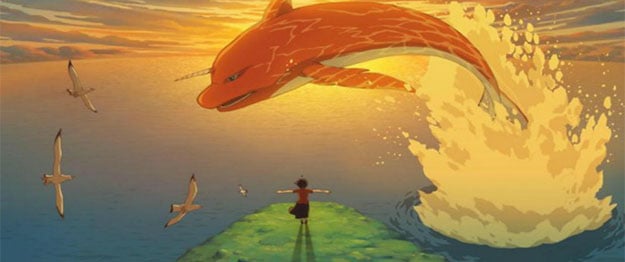
This gorgeous cartoon epic celebrates the shapelessness of water. With designs that look like electrified woodcuts, co-directors Xuan Liang and Chun Zhang plunge us into a primordial time when water covered the earth and the only living creatures were giant fish with human souls.
Then the moviemakers leap into some unspecified age of fable to tell a fish-meets-girl story. The girl, Chun, belongs to a magical group of beings known as “the Others.” The “Begonia” of the title, she can call up the collective power of plants and flowers and grow a mighty tree out of an acorn in mere seconds. Not gods and not mere mortals, either: most of the Others look like humans, and share human drives and emotions, while remaining, mysteriously, other.
The “Big Fish” is a teenage Chinese boy who turns into a dolphin—a mammal. He’s named after “a fish in the Northern Ocean that goes by the name of Kun,” of a size “too large to measure,” as it reads in the opening screen legend. He grows as huge as a killer whale, or orca, which is the largest of the dolphins. In a haunting introduction, Chun speaks as a 117-year-old human woman who believes that a person living life is like a giant fish swimming the sea. She remembers, from her youth, big fish chattering as they fell from the sky. The film goes on to salute steadfastness and metamorphosis in a fluid, changing environment.
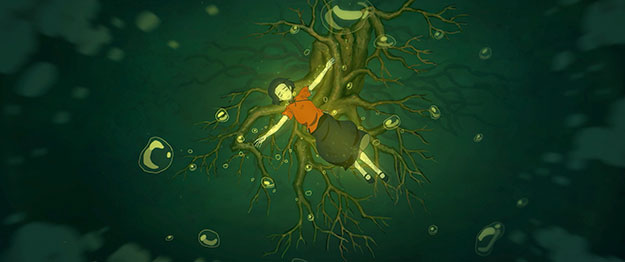
What pulls us into this mélange of cross-species teen romance, coming-of-age story, and occultism is Liang and Zhang’s loving, unhurried creation of an alternative universe. Here, the border of human life is the ocean floor. Chun and the rest of the Others are what lie beneath. Our seas connect to their skies, where red dolphins fly.
Think of the geography of this movie as en existential four-layer cake. First comes the human aerospace, next the human landscapes and seascapes; then comes the atmosphere of the Others’, and their land and sea. Liang and Zhang simultaneously enlarge our view of the known world and sharpen our appetites for the unknown. In turns dizzying and serene, their compositions blend or juxtapose the elemental ingredients of earth, wind, fire, wood, metal, and water. They never stop toying with primal graphic possibilities. Few live-action films make us so exhilaratingly aware of the intersections of sky and sea. In certain realms the characters see only blue, whether they look up or down. The myriad shades of blue in Big Fish & Begonia conjure a cinematic world without end.
In the quasi-folkloric screenplay, the Others serve as guardians for human souls and the laws of Nature. Each has a role in fulfilling their communal duty. When they reach 16, they undergo a weeklong rite of passage to observe the natural laws in action. After drinking magic milk that transforms them into red dolphins, they swim into a maelstrom summoned by a sorceress. It’s their gateway to the Earth’s surface.
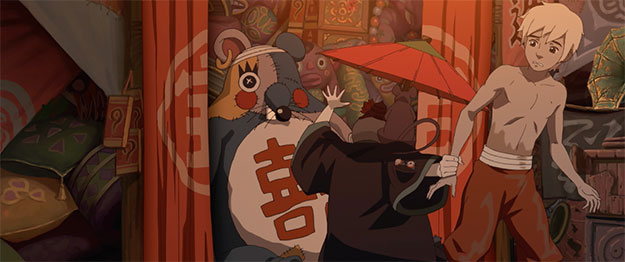
There Chun, in dolphin form, locks eyes with a young human male who adores aquatic life—especially dolphins, and, pointedly, red dolphins. Their dual fate is sealed when the boy frees Chun from a net, and he gets sucked into the same maelstrom that provides her way home. Chun’s quest to restore the drowned boy to life enables Liang and Zhang to fill out their seductive terrain with engaging grotesqueries. Chun visits the Soul Keeper, who resembles a squat Cyclops and makes her pay for reviving him with half her life. Now that the lad’s soul has taken the shape of a dolphin calf (apparently, all virtuous souls become dolphin calves), Chun must protect him until he grows to full strength and can make the journey back to his home, to become a boy again.
The romantic leads seem to trade dolphin and human form—the first of many beguiling and outlandish symmetries. Chun risks all to harbor a human creature, an act that defies the Others and upends Nature. She’s like a one-woman force of climate change: vicious hurricanes and blizzards start pummeling her entire community out of season. Then Chun’s older best friend, a wily, irreverent orphan named Qui, proves to be so hopelessly in love with her that he hazards everything, too, including his whole life.
Qui has read “the ancient books.” He’s the one who playfully suggests they name the boy/dolphin Kun. He even quotes the description of the legendary Kun from the first line of Zhuangzi. Liang and Zhang have cited Zhuangzi and The Classic of Mountains and Seas as influences. Mostly, though, they use these antique Chinese texts as sources of mad inspiration for their own wondrous figures and phenomena.
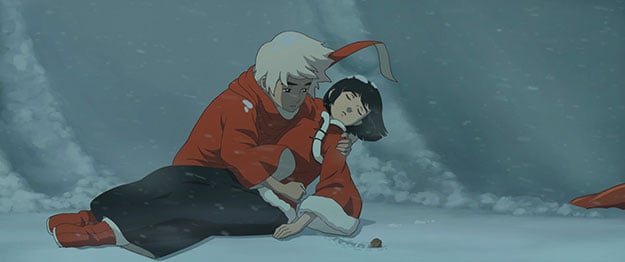
We watch this movie in a state of agitated awe. The directors lead us through wizardly dioramas in a mesmerizing and kinetic museum of supernatural history. In one sequence, a mammoth stone lion comes to fiery life and urges Chun to meet the Soul Keeper’s ferryman: a smooth-faced, one-legged elephant with a single eye in the back of its skull. In another series of vertiginous, ugly-pretty surprises, we meet the Soul Keeper’s opposite number, a buck-toothed, white-faced clownish hag. She collects the straying spirits of human sinners and maintains them not as dolphins, but as vermin. Rats spill out of her enormous stuffed rodent toy.
The movie does, in its own fashion, follow the Taoist spirit. It questions legalistic thinking. It champions the spontaneous inspiration that spurs Chun and Kun to dance a pas de deux as he twirls in mid-air, in the rain. It’s a shimmering cross-species ballet, with Chun’s hands mirroring Kun’s fins and streaking the scrim of drizzle with green lightning. This film conjures a naturalistic pantheism, enveloping every object with the glow of possibility, because anything we see could contain a hidden life.
Primarily, the movie values individuality and self-sacrifice. Chun’s grandfather counsels her to sustain her lonely crusade, as long as she stays true to her “kind heart.” He gives up what’s left of his life to save her buddy Qui; then he transmogrifies into a billowing, hot-pink begonia tree. (Her grandmother, who was the Other in charge of birds, has already died and returned to him as a multi-colored phoenix.)
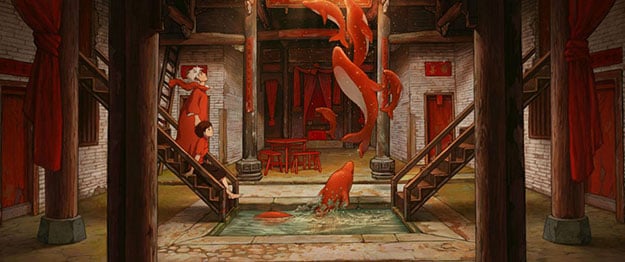
One selfless act builds upon another. The film escalates to a series of linked climaxes. When a rampaging flood threatens the existence of the Others, Chun uses her life force and power over flora to unite her body with her grandpa’s begonia tree. She hopes it will grow massive enough to stave off the angry waters.
Chun is appealingly ardent and Qui is intriguingly unpredictable. We root for each of them. It comes as a relief when the film finally addresses Qui’s destiny halfway through the closing credits, because he’s too lovable a character to meet an abrupt end. (The script does leave one or two loose threads, including the fate of the hag-clown/rat-keeper, perhaps providing room for a sequel.)
Even the movie’s absurdities, excess, and carelessness pique our interest. The directors can’t find a good solution to presenting full-frontal nudity in a cartoon feature: they give the buck-naked Kun the same physique as an Academy Award statue. They are freer when it comes to scatology. A white horse takes a dump on Qui’s head, and one of the Soul Keeper’s cats soils his carpet. Kun gets tossed down a sewer, where Qui dives in after him. After all, when asked where the Tao or “the Way” exists, Zhuangzi says, “There’s no place it doesn’t exist . . . It is in the piss and shit.”
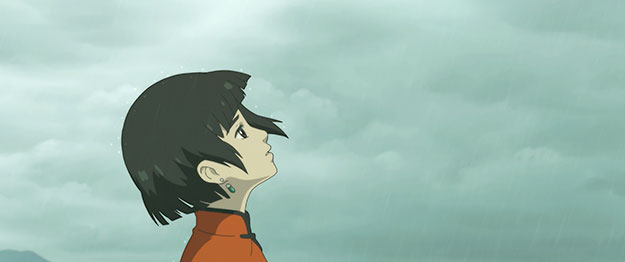
This feature began as a short of the same name in 2004. That was the last year for any confirmed sighting of the baiji, or Chinese river dolphin, also known as the Goddess of the Yangtze River. If there are no more baiji out there, it will mark the first time pollution-spewing industries, destructive fishing techniques, and other human activities have driven a dolphin species to extinction.
Spinning their own variations on ancient Chinese myths, these directors make a poetic plea to protect actual species—while delighting audiences with transcendent make-believe.
Michael Sragow is a contributing editor to Film Comment and writes its Deep Focus column. He is a member of the National Society of Film Critics and the Los Angeles Film Critics Association, and a contributor to the Criterion Collection.







